How SpaceX's private Polaris Dawn astronauts will attempt the 1st-ever 'all-civilian' spacewalk
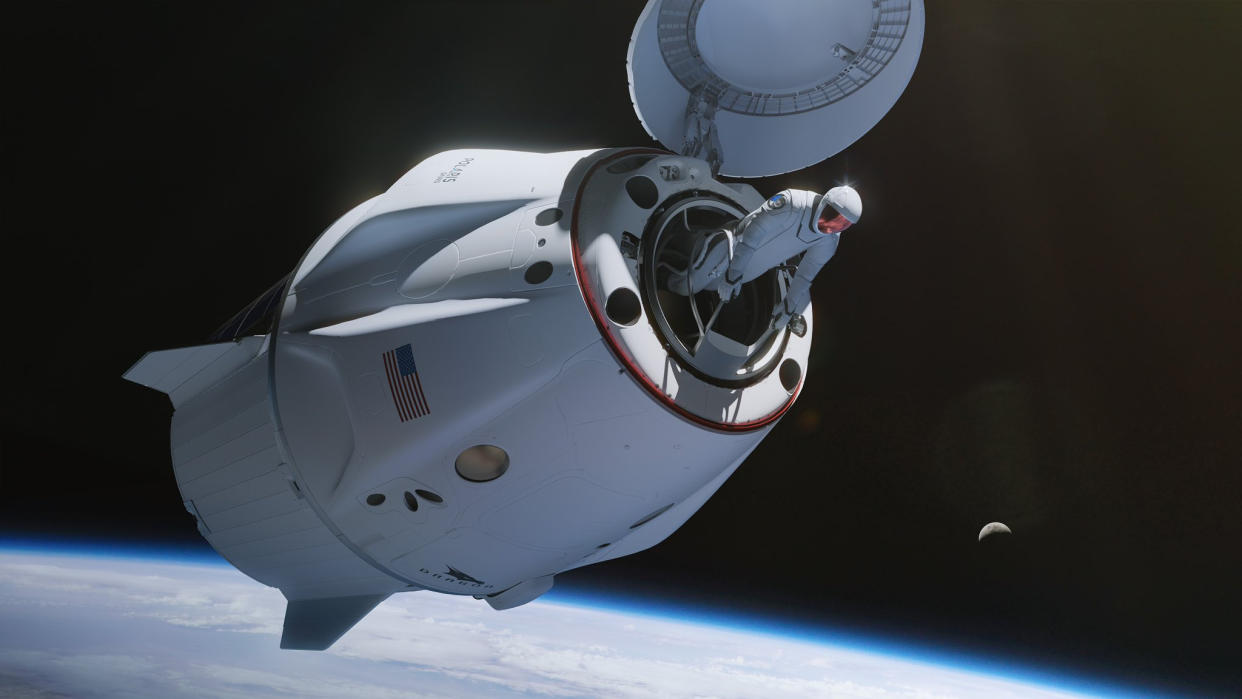
- Oops!Something went wrong.Please try again later.
SpaceX's most ambitious crewed mission to date is gearing up to launch this summer — it will include the company's first spacewalk-capable spacesuits and a Crew Dragon capsule with an interior modified for vacuum exposure.
Polaris Dawn is the first of three anticipated missions in the Polaris Program, funded by billionaire philanthropist Jared Isaacman. The endeavor is a follow-up to SpaceX's Inspiration4 launch that occurred 2021, which flew Isaacman and three other private citizens on the first all-civilian flight to space. Through Inspiration4, Isaacman was able to help raise $250 million for St. Jude Children's Research Hospital in Memphis, Tennessee, and he hopes to carry that momentum into Polaris Dawn as well as the program's subsequent missions.
In an effort to continue pioneering private spaceflight, Isaacman and the Polaris Dawn crew will fly their Dragon spacecraft higher than any crewed mission since the Apollo Program ended in the 1970s. During their flight, the crew will also test and validate SpaceX's new and improved spacesuit design in the vacuum of space, collectively undertaking the first all-civilian extravehicular activity (EVA) event.
Related: SpaceX reveals new EVA suit for 1st private spacewalk on upcoming Polaris Dawn spaceflight (video)
Polaris Dawn crew
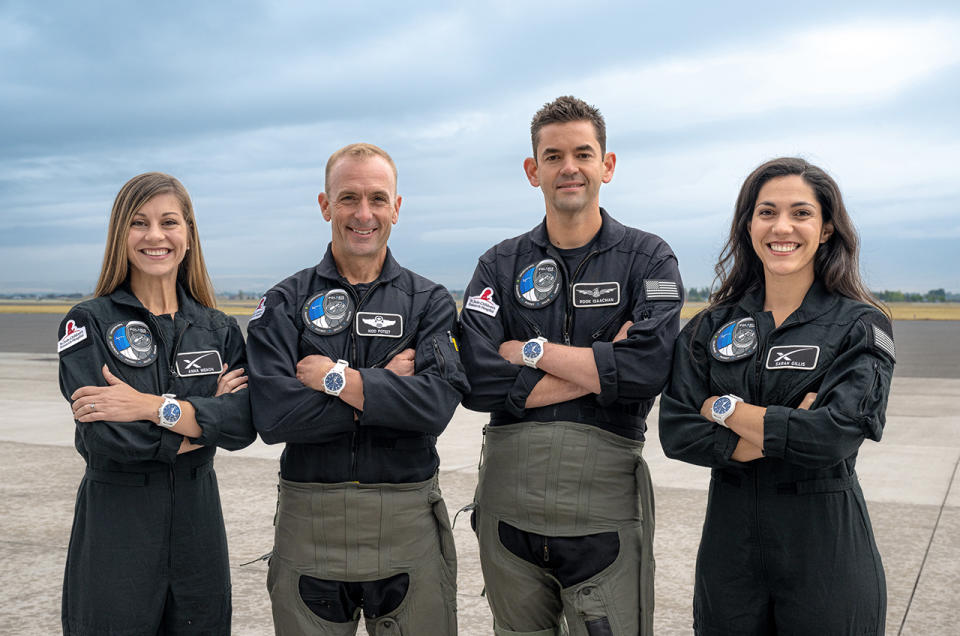
The Polaris Dawn mission will also be the first time a SpaceX employee will strap-in to a Crew Dragon and ride one of the company's Falcon 9 rockets to space.
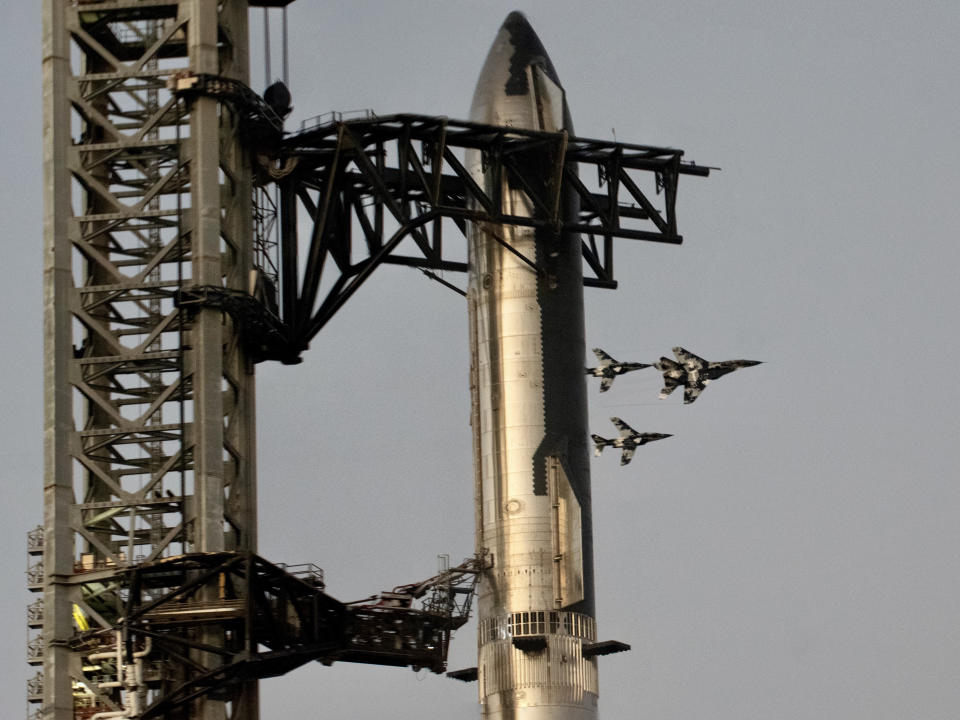
Training
When it was first announced, the Polaris Dawn team had aimed for a late 2022 launch date. That date was eventually pushed back to early March 2023, then finally to the summer of 2024. The delays were due in part to hardware development timelines, most notably for the design and manufacturing of SpaceX's EVA suit.
In the three years since Inspiration4, Isaacman and the Polaris Dawn crew have been busy training for their upcoming mission. Taking a page from NASA's playbook, a large portion of this training was focused on group cohesiveness and teamwork. Poteet described some of the crew's training during a "Spaces" discussion on X, formerly Twitter, on May 4. "We've kind of piled on to what NASA has done over generations as far as identifying environments and situations that are stressful," he said, adding that those situations have allowed them to learn the strengths and weaknesses of their teammates, as well as themselves.
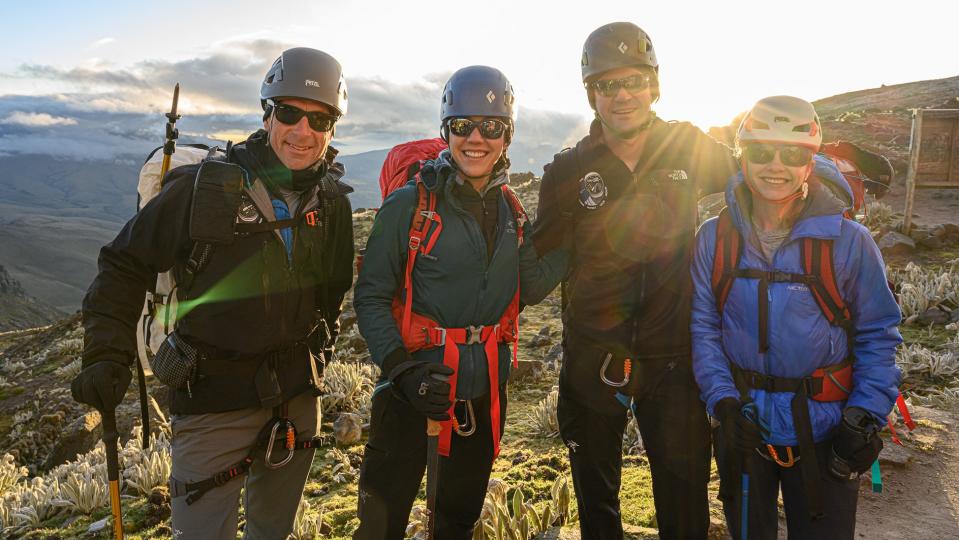
As Poteet explains, over the past few years, the crewmembers have traveled together while gaining exposure to a myriad of environments and situations that have put them to the test. Their training has included scuba diving, mountain climbing, skydiving and high-G jet flights. "All these environments induce a level of stress that allows us to get comfortable in these uncomfortable scenarios," he said. "We've had some great experiences and we're just looking forward to putting it to the real thing come launch."
EVA Training
While the Polaris Dawn crewmembers did have the opportunity to complete some of their high-G training at NASA's Johnson Space Center (JSC), in Houston, one thing they did not have access to was the pool near the space center known as the Neutral Buoyancy Laboratory (NBL). NBL is famous for its use in training astronauts on EVA procedures, as well as its submerged replica of the ISS.
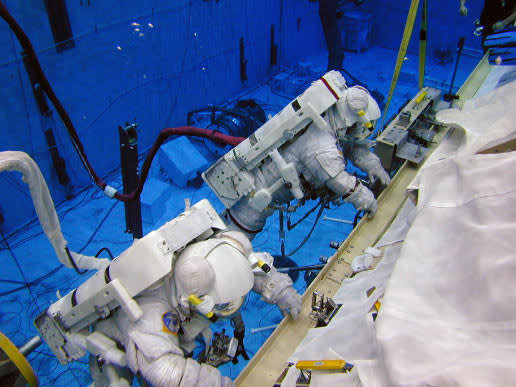
Rather than take things underwater, SpaceX engineers at the company's headquarters in Hawthorne, California, rigged up an elaborate system of ropes, pullies and counterweights inside a Dragon capsule simulator that mimics the effects of microgravity. Gillis explained ins and outs of that system during the X discussion.
"Typically, when you hear 'EVA,' the first thought is: build a pool using neutral buoyancy as a means of simulating the microgravity environment," she said. "We've been on, obviously, a much shorter development cycle — and putting a suit into the pool has its own challenges. So, the SpaceX team really approached it from a different and new direction of finding means of doing that outside of water."
She continued that, in the team's Hawthorne facilities, there's a vertical capsule simulator within which engineers managed to place a suspension system with innovative controls. "If you tap something with your finger," she said, "you move very similarly to what you would experience in microgravity."
Gillis paints a picture of a pressurized suit in a suspension system that can sort of replicate what it'd be like to step out of a spacecraft's hatch opening. "You can suspend a crew member sideways and practice hatch operations in a very high-fidelity microgravity environment simulation," she said.
EVA Suit
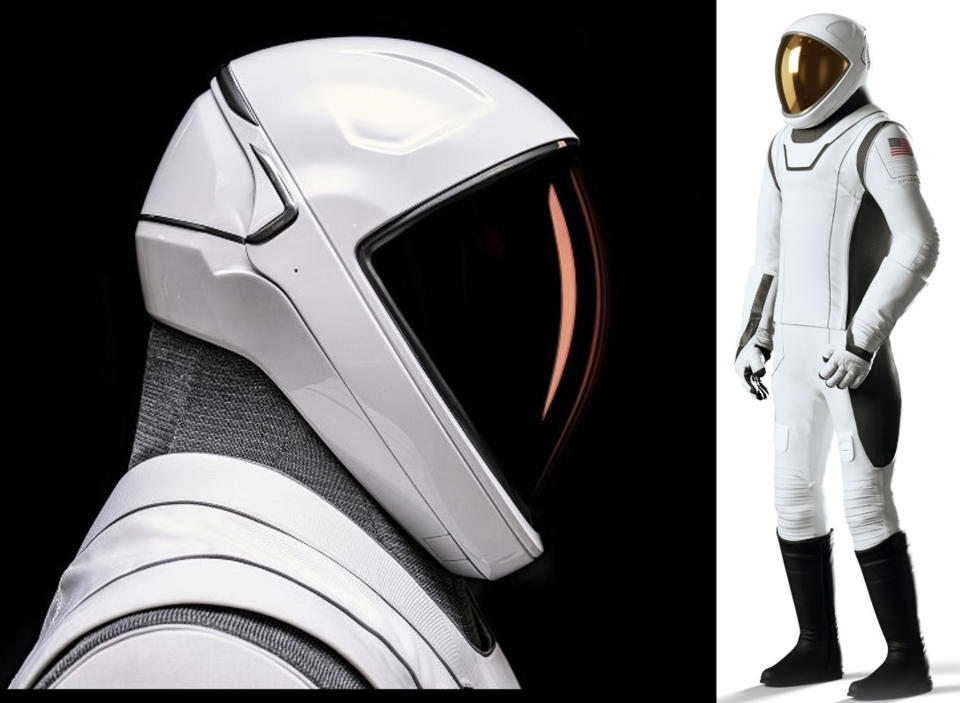
SpaceX unveiled its new EVA suit on May 4, revealing what looks like a thicker version of the company's intravehicular activity (IVA) spacesuit, worn by astronauts during previous launches and landings aboard Crew Dragon. Chris Trigg is SpaceX's manager of spacesuit design, and also joined the X Spaces discussion.
"One challenge actually was to make sure that we kept all the functionality of the IVA suit, in addition to adding the EVA capability," Trigg said. To prevent unnecessary bulk within the spacecraft, the Polaris Dawn crew will be leaving their IVA suits behind, only needing their EVA suits throughout the mission. "We're using a single suit on the Polaris Dawn mission, so the crew will be wearing it out to the pad all the way through splashdown," Trigg said, adding, "we wanted to make sure that everything the current IVA suit could do, we maintain that functionality, but then also made it EVA-capable as well."
Enhancements to bring the IVA suit design up to EVA specs included upgrading the suit's thermal management system, for instance, which involved materials sourced from the Falcon 9 rocket's interstage section itself as well as Dragon's trunk. Other upgrades included a new coating on the helmet's visor and the addition of in-helmet information displays and cameras. The new copper-colored visor is treated with the same indium tin oxide coating process that Inspiration4's cupola underwent. (That's the window that allowed the Inspiration4 crewmembers to practically stick their heads outside the spacecraft.)

"The visor is serving a lot of functions," Trigg explained. "It's helping to seal the suit and retain pressure; it's obviously the optical porthole for the crew to see outside; it has to manage the thermal environment as well — and then, of course, it also has to protect, just like a pair of sunglasses, from preventing too much light and harmful wavelengths of light from entering the suit."
The EVA suits also feature an umbilical port for life support functions while the crew is exposed to the vacuum of space, as well as an added cooling knob to adjust internal temperatures. Furthermore, technicians gave extra attention to reevaluating and improving the suits' joints and mobility capabilities.
"One of the joints that we worked really hard on are the rotators on the arms, the shoulders and the wrists, which allow the rotation of those joints. They're unique in that, when they're unpressurized, they stay soft and flexible so that during dynamic phases of flight, like launch or reentry, you don't have hard, metallic objects that are kind of loading into the body of the crew members. They stay soft. Then, when you pressurize the suit, they rigidize and give you that mobility that you need," Trigg said.
The Mission+Research
When Polaris Dawn launches, the crew will rocket into a highly elliptical orbit, reaching a maximum altitude, or apogee, of 745 miles (1,200 kilometers) and a minimum altitude, or perigee, of about 118 miles (190 kilometers). After a few orbits, Dragon will the raise its apogee to 870 miles (1,400 kilometers) — that's higher than any human has flown since the final Apollo mission in 1972. It's here where the Polaris Dawn crew will conduct most of their research.
Polaris Dawn's orbit reaches out into portions of the Van Allen radiation belt, which are sections of magnetically trapped, highly energetic charged particles located between Earth and the moon. Much of human spaceflight over the past three decades has researched the effects of microgravity and radiation on the human body in low-Earth orbit (LEO), but not in deep space.
"It's an awesome opportunity for us to get some data, but really it's about kind of pushing beyond our comfort zone and where we've been at for the last 20-some-odd years at an awesome orbiting laboratory, the space station," Isaacman said during the May 4 discussion. "But, if we're going get to the moon, Mars and beyond, we've got to start venturing out a little bit farther."
Over their five days in space, the Polaris Dawn crew will conduct around 40 experiments. The mission website includes an extensive list of research the team is hoping to complete, and summarizes the bulk of them as follows:
Using ultrasound to monitor, detect and quantify venous gas emboli (VGE), contributing to studies on human prevalence to decompression sickness;
Gathering data on the radiation environment to better understand how space radiation affects human biological systems;
Providing biological samples towards multi-omics analyses for a long-term Biobank;
Research related to Spaceflight Associated Neuro-Ocular Syndrome (SANS), which is a key risk to human health in long-duration spaceflight.
Polaris Dawn also hopes to conduct a laser-communication experiment using SpaceX's Starlink satellite megaconstellation network. "We have something super exciting planned for that — it's a really big deal," Isaacman said.
While he didn't elaborate on what that might be, he emphasized its importance in laying the groundwork for human spaceflight on a much larger scale, "potentially hundreds of Starships in the future," Isaacman said, and highlighted the goal of reducing dependencies on "legacy ground stations or TETRA satellites."
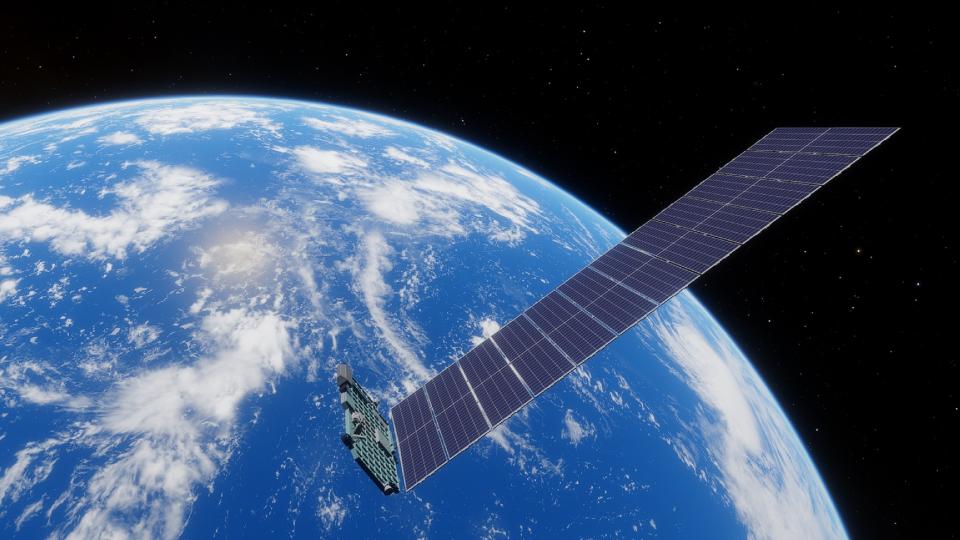
EVA
After completing the bulk of their research in the mission's highly elliptical orbit, the Polaris Dawn crewmembers will lower their apogee to about 435 miles (700 kilometers), where they will conduct their EVA. Amongst all the research on the mission's docket, testing and validating the new suits will not only mark a significant milestone for Polaris Dawn and the Polaris Program, but also for SpaceX.
On the ISS and certain other space stations and spacecraft, including NASA's retired space shuttle, exiting the vehicle involves sealing EVA participants in an airlock, hermetically isolated from the rest of the spacecraft, which then depressurizes slowly into a vacuum. This prevents explosive decompression due to the differences in air pressure suitable for human life (maintained by life-support systems) and the cold, hard vacuum of space.
Another way astronauts prepare for an EVA is similar to procedures performed by deep-sea divers or high-altitude pilots — they undergo a pre-breathe protocol designed to purge the body of nitrogen gas, which causes decompression sickness.
However, without an airlock, Dragon's entire cabin must be vented and exposed to space, making Polaris Dawn's pre-EVA procedures different from those historically observed aboard the ISS, and changing the crew's pre-breathe routine.
"The difference is that [astronauts aboard the space station] will often just breathe 100 percent oxygen for a very prolonged period of time, or do an exercise routine to try and purge the nitrogen from their system, in which case, you have less concern about experiencing decompression sickness," Isaacman explained. "Now, the problem is we don't have an airlock on Dragon, so we can't just sit in there for hours on end breathing 100 percent oxygen to rid ourselves of that nitrogen. We have to take a different approach."
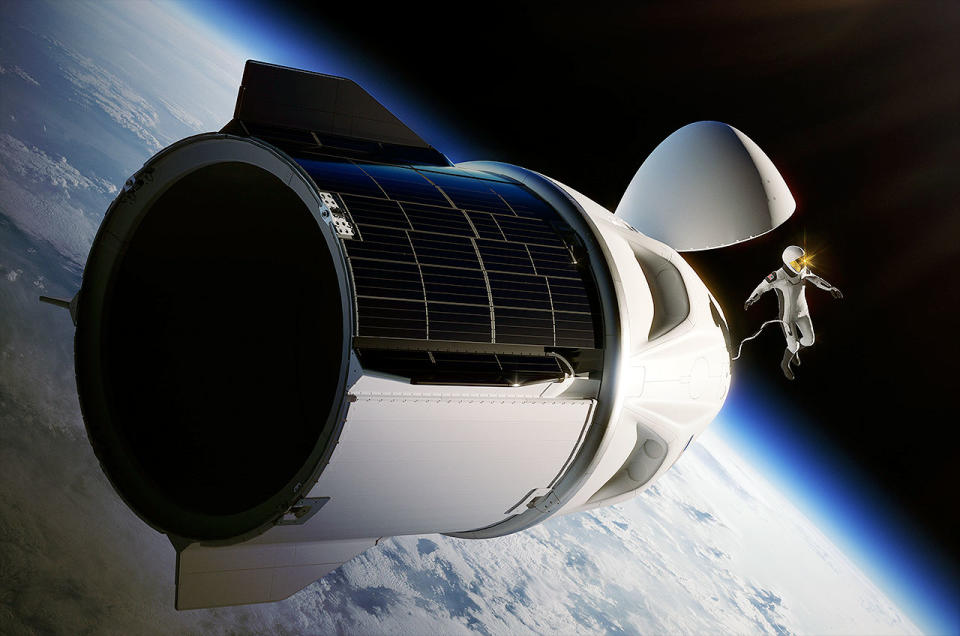
Over several days, the pressure inside Crew Dragon will slowly lower as partial pressure of oxygen (PPO2) levels gradually rise. Isaacman compared the pressure change to that of visiting Denver, which has an elevation of 5,280 feet (1,610 meters). "Over that time period of being at what our bodies thinks is a higher elevation, we are slowly purging nitrogen from our system," Isaacman further explained. "Then, we will switch to 100 percent O2 in our suits for a period of time when we are venting down the capsule, and then we will conduct the entire operation at 100 percent O2."
From there, with the entire cabin vented and the hatch open, all four Polaris Dawn crew members will be exposed to the vacuum of space; this EVA will not only be the first conducted by any private citizen, but also the largest ever by participation.
Typically, the EVA tasks performed outside the ISS by NASA astronauts and Roscosmos cosmonauts are undertaken by two people at a time. In fact, the only three-person EVA ever performed was during the STS-49 space shuttle mission, which was an impromptu EVA that only came about as a result of a pair of previously unsuccessful EVA attempts and the hopes that three astronauts could complete a task that two could not.
Crew Dragon
While Crew Dragon's design was tested and qualified for vacuum exposure, scenarios in which such exposure could occur all fell in the category of "emergency." In order to make the Polaris Dawn Dragon EVA-ready, the spacecraft's interior had to thus undergo some refurbishment.
As such, SpaceX technicians removed any components or materials unable to withstand vacuum exposure for extended lengths of time and added footholds and handholds in the cabin for increased stability, including a mobility interface apparatus (a ladder, basically) at Dragon's forward hatch. SpaceX engineers have named the ladder "Skywalker," and it is designed to provide extra security as astronauts egress the spacecraft.
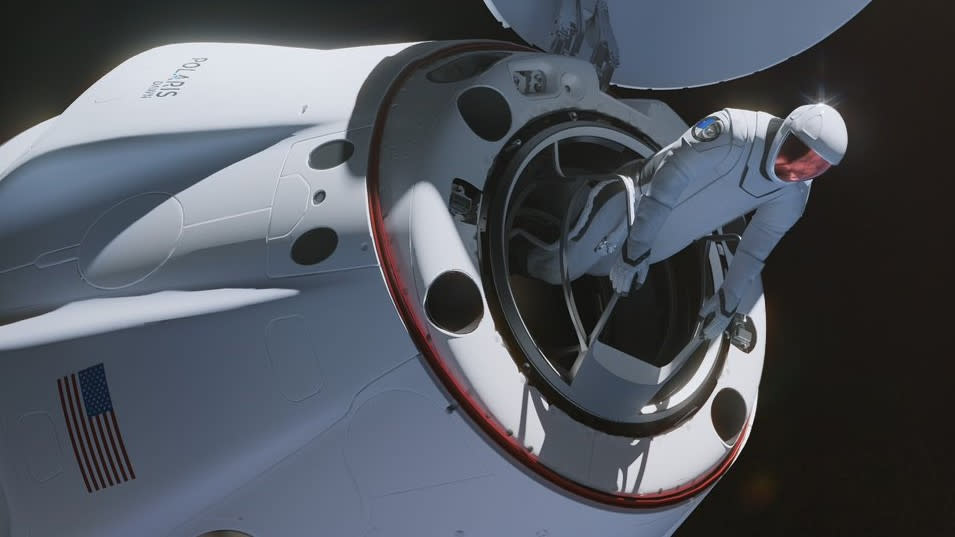
Polaris Dawn's Crew Dragon interior also houses a new nitrogen repressurization system for use at the conclusion of the crew's EVA.
Gillis explained some of the reasons behind the modifications during the May 4 X discussion, saying, "all of our life support is going to be coming from the vehicle — oxygen tanks inside the spacecraft fed through an umbilical to our suits. Umbilicals provide our electronics; our life support. That is really our connection to the vehicle. We effectively have to fly all of those consumables — and so, in order to both account for the full mission duration and make sure we can test [the EVA suit and procedures], the operation is going to be scoped to about two hours end to end. And that includes venting the capsule, external operations and then re-pressurizing the capsule as well."
She also broke down some of how the Polaris Dawn EVA will utilize that two-hour window. "Outside the spacecraft, two crewmembers will go through a test matrix, effectively, to get SpaceX the data that they're hoping to see," she said, adding that tests would mainly be focused on the suit's performance and mobility in microgravity conditions.
SpaceX also wants to use this opportunity to validate the way they train astronauts for future EVAs. "We have this ground-validated system for training, but we're also equally validating that training method in the microgravity environment to see if there are nuances we didn't quite capture in our simulated environment," Gillis said.
Future Polaris Program missions

Details about the second and third flights of the Polaris Program have not yet been announced, but Isaacman has said the last Polaris mission will use SpaceX's Starship, provided the vehicle is ready for flight. He also proposed the possibility of using future flights as a means to preserve and prolong aging space missions.
Related Stories:
—Elon Musk shows off fully-stacked SpaceX Starship as 1st orbital launch nears
—SpaceX's private Inspiration4 crew gets their astronaut wings
—Inspiration4: How Jared Isaacman's kindergarten space dream became a pioneering SpaceX mission
For instance, NASA is considering a private vendor to service the Hubble Space Telescope after the Polaris Program raised the possibility of boosting the observatory into a higher orbit. Isaacman also recently wrote a letter to NASA administrator Bill Nelson voicing his concern over U.S. Congress funding shortfalls leading to the cancellation of the Chandra X-ray Observatory.

